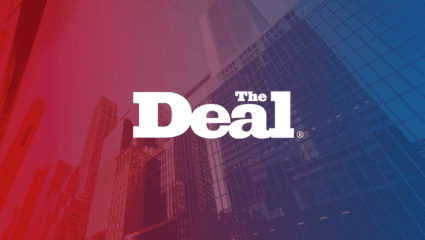TDE Middle Market: Covid Offers Opportunities for Cross-Border M&A

The coronavirus pandemic has made cross-border dealmaking harder but has also created opportunities for private equity, according to One Equity Partners managing director Andrew Dunn.
Speaking to a virtual audience at The Deal Economy: Middle Market Week on Wednesday, July 29, Dunn said the use of antitrust tools for protectionist goals had not begun with the crisis, but as the geopolitical tensions between the U.S. and China had “certainly intensified” since the start of the pandemic, there were new openings for financial sponsors to step in.
“We’ve made a point of looking in some of the sectors, in the technology domain in particular, where we think that a Chinese buyer would not be able to play, because of these concerns,” he said. “We think we have opportunities and can create solutions for some of these companies, where previously they would have looked to a different kind of buyer.”
“The pitch has been: ‘You may be in the too-small range for U.S. or European buyers, or too regionally or geographically focused. Let us help you with capital to build up your businesses so that you can be appealing to those buyers.'”
Dunn was speaking on a panel, Navigating Cross-Border Deals, moderated by The Deal’s Lisa Botter, that examined the effect of the coronavirus crisis on international dealmaking.
More specifically related to the logistical issues raised by the crisis was Dunn’s view that the disruption in previously friction-free supply chains would also provide opportunities for M&A activity.
Strategics and financial sponsors may look to smooth that disruption because of changes in the strategic rationale that was driving cross-border deals. Companies that had previously relied on outsourced, Asian supply chains had now seen firsthand the challenges that even a “tiny” disruption could bring.
“I think we’re going to see people racing to bring certain aspects of their operations onshore or nearer shore. And the fastest way that they can achieve that in some cases is going to be M&A activity,” Dunn said.
Also on the panel were Rob Carlon, director for corporate development at Smiths Group plc, and Paul Humphreys, corporate and M&A partner at law firm Freshfields Bruckhaus Deringer LLP.
Carlon, who confessed he was “raring to get on a flight,” spoke of the difficulties of having to work via video conference, especially where there were cultural differences or language issues which would be “harder to break down over Zoom calls.”
For Carlon, “physical meetings and meeting in person and all the things around that” were really critical, particularly in building a relationship from the beginning.
“Once you’ve met someone and you’ve built that rapport,” he said, “it’s much easier to follow on with calls and so on. But it’s really hard to build that rapport over Zoom calls. There’s something about physical meeting that I think will continue in the future as well.”
Carlon was coming from the perspective of an engineering and manufacturing company and said that for due diligence and contact with stakeholders, he would perhaps rely more on visiting sites and physical presence than lawyers or financial investors. Dunn, for instance, had spoken of an increase in “the velocity of transactions” over Zoom, with “lots of Zoom calls” replacing two-day workshops, where a team would then “go away and think about things and come back in a couple of weeks’ time.”
Nevertheless, Carlon spoke of how some of those obvious problems were being dealt with in innovative ways during the crisis. Management presentations, for instance, had been moved online. Instead of site visits, you had “people walking around with cameras,” showing the site and the machinery and “trying to think outside the box about what can you do with technology to solve these problems.”
He took the view, however, that while there would definitely be a lull in M&A activity as businesses worked out how to build new relationships and “kick off new transactions,” the pandemic was not the first crisis to have hit dealmaking.
This was, he said, a short-term problem.
“You’ll see in years to come that M&A will come back. Travel will start to come back,” he said. “It’ll be interesting to see how this new phase of transactions that are kicking off now will get to signing and closing and what the time frame for that is. But in terms of quantity of transactions, I don’t think there’ll be much change if you look forward.”
For both Carlon and Dunn, there were questions on how to value targets during the crisis. Not only were there difficulties of not being able to travel, which for Carlon in particular made it hard to work out what a deal would achieve in terms of cost synergies, but also changes in the markets for goods and services. How would an investor know whether a decline, or for that matter a bump in revenue and share prices for a company or sector, were related to the crisis or part of a long-term trend? Airlines might be down now, while the health sector and video conferencing technologies were booming. But what would happen after the crisis?
“We’ve been sanity checking everything we do, frankly, by looking at 2019 and what we think 2021 should look like,” Dunn said.
Humphreys, meanwhile, pointed out how much harder it had become for the sell-side adviser to put a deal together, in terms of getting a data room organized, when “no one is sitting at their desktop with access to all the information that [Dunn and Carlon] are going to want to see.”
But for him, there was also a need for regulatory and legal certainties. The negotiations on deal documentation had become really intense, he said, particularly with a focus on what kind of flexibility a seller would need to respond to a dynamic and changing situation during the period between signing and closing.
Deals in the U.S. were most often done with a closing condition that stipulates that if a seller has not complied in all material respects then the buyer will have a walkaway right. Moreover, “pre-Covid,” most European and Asian deals were done on a “locked box” basis, where the deal terms were based on the state of the balance sheet at the time of signing. In the U.S. the majority of deals were done on a “completion accounts” or “purchase price adjustment” basis, where changes could still be made at the time of completion.
“I have a lot more discussions now with my colleagues in Europe,” Humphreys said, “about using that purchase price adjustment architecture to try to bridge value gaps or put some guard-rails on how a business is going to perform and who takes that risk between signing and closing.”
Tools used in normal times such as earnouts and deferred consideration models “are on the table to help people to deal with all the challenges,” he added.
All three panelists agreed that the regulatory environment had become more complex because of the pandemic, which had not only driven an expansion of what governments now saw as a potential national security issue (availability of vaccines and medicines being an obvious example, as well as food and agriculture), but also added to the length of time that regulators were taking to examine deals for antitrust or competition implications.
Regulators were working from home, too, they pointed out, so things were taking longer. But they were also working in a changed political environment, with greater scrutiny demanded of foreign, particularly Chinese, but also European investment in the U.S., for instance. While all agreed that the increase in protectionism and economic nationalism that underlay that change predated the arrival of the coronavirus, the pandemic had added an additional layer of complexity and caution. That was true in the U.S. but also in Europe, where the rules that were designed to prevent Chinese or other investors from snapping up valuable assets on the cheap after they had taken a hit from the virus differed from country to country even within the European Union.
Said Humphreys, “It’s important not to lose sight of the fact that the foreign investment issue is certainly a China story, but it is also a bigger story for cross-border M&A.”
Editor’s note: The original version of this article was published earlier on The Deal’s premium subscription website. For access, log in to TheDeal.com or use the form below to request a free trial.



